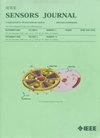Rapid Detection of Mixed Odor Intensity Level in Composting Plants Based on E-Nose
IF 4.3
2区 综合性期刊
Q1 ENGINEERING, ELECTRICAL & ELECTRONIC
引用次数: 0
Abstract
It is essential to be able to precisely identify the intensity level of the malodor in order to have a clear perception of and strong control over the pollution level of mixed malodor emissions. In this study, mixed malodors from a composting facility were utilized as test samples, and the malodor samples were analyzed and evaluated using data from the triangle odor bag method and the electronic nose instrument. Next to the extraction of the feature values from the mixed malodor response signals recorded by the electronic nose, dimensionality reduction was carried out using both principal components analysis (PCA) and linear discriminant analysis (LDA), and classification and identification were carried out in combination with support vector machines (SVMs), decision trees (Tree), and基于电子鼻的堆肥混合气味强度快速检测
为了对混合恶臭排放的污染程度有清晰的认识和强有力的控制,必须能够准确地识别恶臭的强度水平。本研究以某堆肥设施的混合恶臭为测试样本,利用三角臭袋法和电子鼻仪的数据对恶臭样本进行分析和评价。在对电子鼻记录的混合恶臭响应信号进行特征值提取的基础上,结合主成分分析(PCA)和线性判别分析(LDA)进行降维,并结合支持向量机(svm)、决策树(Tree)和${k}$近邻(KNNs)进行分类识别。利用电子鼻对混合气味的响应信号与人工嗅觉辩证法的结果之间的相关性,是将恶臭浓度与人类感官嗅觉相关联的一种很好的方法。实验结果表明,KNN与LDA相结合的训练准确率达到96.4%,验证准确率达到95.7%。让他们有更直观的感觉,这样养牛场和家禽养殖场的工作人员就能更好地管理和控制恶臭的传播,并给出有效的指示。
本文章由计算机程序翻译,如有差异,请以英文原文为准。
求助全文
约1分钟内获得全文
求助全文
来源期刊

IEEE Sensors Journal
工程技术-工程:电子与电气
CiteScore
7.70
自引率
14.00%
发文量
2058
审稿时长
5.2 months
期刊介绍:
The fields of interest of the IEEE Sensors Journal are the theory, design , fabrication, manufacturing and applications of devices for sensing and transducing physical, chemical and biological phenomena, with emphasis on the electronics and physics aspect of sensors and integrated sensors-actuators. IEEE Sensors Journal deals with the following:
-Sensor Phenomenology, Modelling, and Evaluation
-Sensor Materials, Processing, and Fabrication
-Chemical and Gas Sensors
-Microfluidics and Biosensors
-Optical Sensors
-Physical Sensors: Temperature, Mechanical, Magnetic, and others
-Acoustic and Ultrasonic Sensors
-Sensor Packaging
-Sensor Networks
-Sensor Applications
-Sensor Systems: Signals, Processing, and Interfaces
-Actuators and Sensor Power Systems
-Sensor Signal Processing for high precision and stability (amplification, filtering, linearization, modulation/demodulation) and under harsh conditions (EMC, radiation, humidity, temperature); energy consumption/harvesting
-Sensor Data Processing (soft computing with sensor data, e.g., pattern recognition, machine learning, evolutionary computation; sensor data fusion, processing of wave e.g., electromagnetic and acoustic; and non-wave, e.g., chemical, gravity, particle, thermal, radiative and non-radiative sensor data, detection, estimation and classification based on sensor data)
-Sensors in Industrial Practice
 求助内容:
求助内容: 应助结果提醒方式:
应助结果提醒方式:


